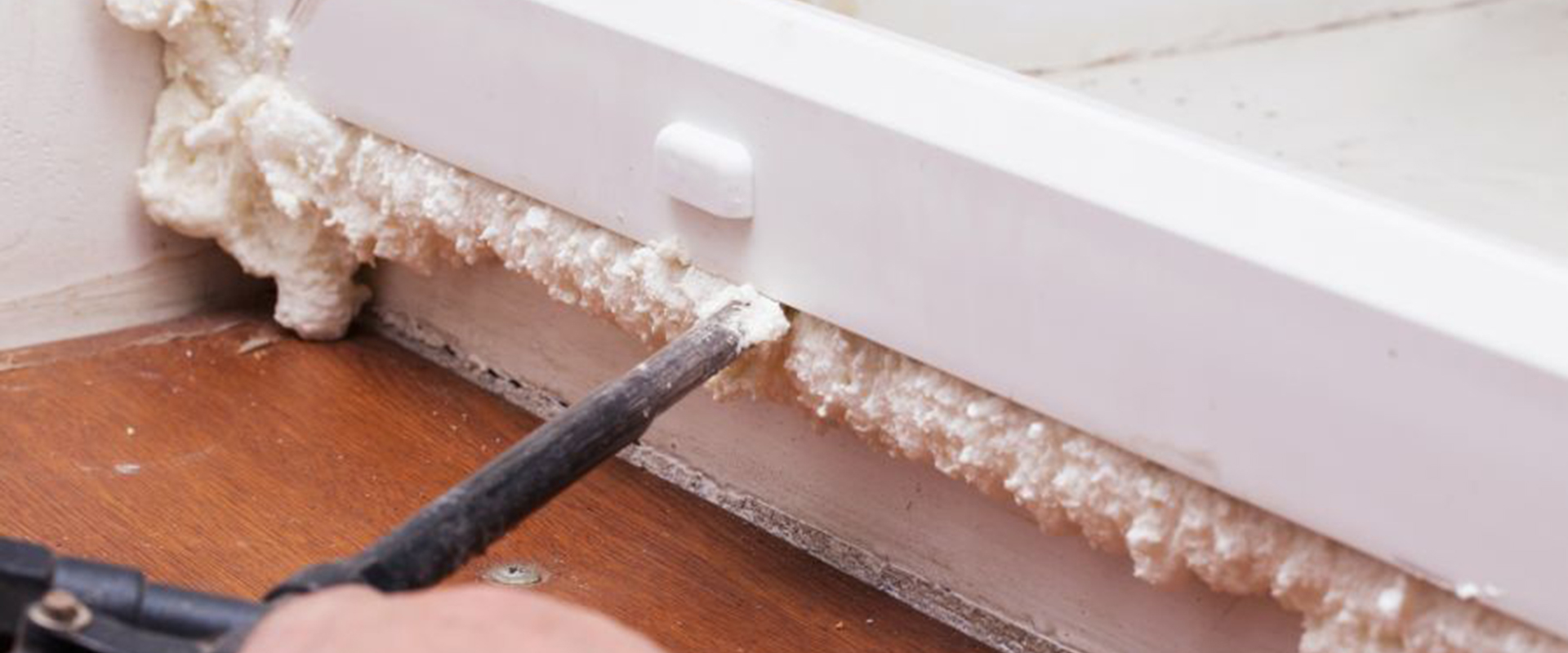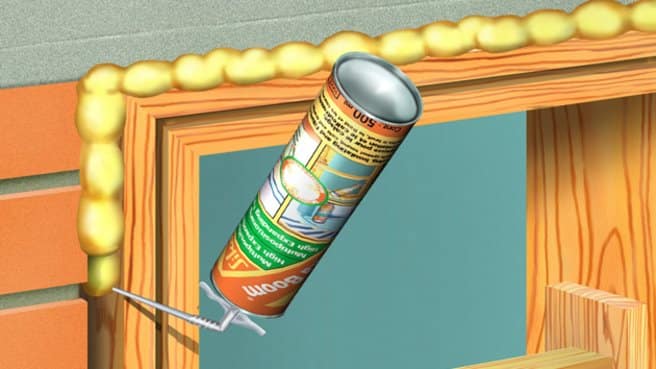A customer recently joined Calfeutrage Élite with a sensitive question about caulking techniques related to sound insulation, and with an initial answer, he extended his question to the use of PU insulating foam insulation (or polyurethane foam).
Here is a summary of the exchange of words:
I have windows to change in a room for which I am doing renovations. There are large fixed panels in the same frame as the opening flaps.
What is polyurethane foam (or insulating expansive foam)?
Expanding foam, also known as polyurethane foam, is a go-to choice for building insulation and caulking. This versatile material provides exceptional thermal and acoustic protection by hermetically sealing cracks, joints and voids.
Why choose polyurethane foam? First, its ability to adhere to a variety of substrates makes it an effective shield against drafts, moisture, and noise, improving the overall energy efficiency of your construction.
The benefits of expanding foam are numerous. In winter, it reduces heat loss, while in summer, it prevents fresh air infiltration. By creating an airtight barrier, it also prevents moisture and mold problems. Its versatility allows it to be applied to a variety of surfaces, whether wood, concrete, metal or plastic, making it an ideal choice for all your caulking projects.
By investing in the use of polyurethane foam, building owners can improve energy efficiency, increase indoor comfort, and ensure long-lasting protection from the elements. Choose insulating expanding foam for exceptional insulation performance.
How do I make sure I have good sound insulation?
- An expansive seal mark?
- A silicone brand?
- Injected polyurethane foam?
- An acoustic contractor?
- Or maybe just laying tips?
Shawn’s response,“Mr. Elite Caulking”
Choose quality windows
The most important is the glazing. At a minimum, provide a 10/16/4 FE-argon.
The joining (also known as caulking) and the installation must meet the specifications of DTU 36.5.
There is not typically a specific seal for acoustics, from the moment the seal is designed and implemented to ensure perfect air and water sealing, it will be suitable for acoustics.
This is, for example, a type of seal perfectly suited for a renovation installation with excellent ISO-BLOCO Max 600 acoustic performance: http://www.iso-chemie.fr/
It is a self-expanding, waterproof and air-tight foam seal that does not require a silicone seal.
There is another brand: ILLMOD 600 by Tremco Illbruck: http://www.tremco-illbruck.fr/produits/02384_index.html
Be careful especially no foam PU aerosol can,it is also forbidden in the DTU 36.5 in caulking product.
Question:
Why is expanding foam spray not recommended?
Many people wonder why PU foam spray is sometimes advocated by some, despite being banned in certain situations.
The answer is as follows:
Insulating expanding foam can in no way guarantee an air and water tightness between the wall and the frame of the new joinery, or between the old frame and the new frame when renovating on existing frames. It is precisely this function of airtightness and watertightness that is called, in technical language, caulking.
Aerosol PU foam is actually perfect for improving thermal insulation and filling the gap between the lining and the new frame, thanks to its excellent insulating power, which is significantly higher than that of glass wool, for example. In summary, if you use aerosol PU foam to replace glass wool, you’re fine. On the other hand, if you use it instead of a silicone gasket for caulking or a pre-compressed foam strip, you’re in the wrong place, as it doesn’t provide the required seal.
Question
But doesn’t silicone provide air and water sealing? to supplement the injected PU foam?
Answer
No, silicone is only used in waterproofing on the outside
and only on a foam seal background, to ensure the seal between two flat faces at least 5mm apart.
It must be continuous, perfectly regular and perfectly smoothed after being extruded carefully.
In addition, it must be compatible with the materials of both supports and not out of date.
The foam seal bottom is used only to limit the thickness of the silicone putty during extrusion and then allow the compression of the putty during smoothing to have a good grip on the 2 supports.
Once the silicone putty is reticulated, the foam seal bottom is no longer useful.
PU aerosol foam is ONLY indoors at the dubbing level and for thermal insulation without any waterproofing function.
PU aerosol foam with silicone is not put on top because PU aerosol foam is not intended to serve as a seal background for a silicone putty. Irregularities caused by the expansion of the foam would not ensure a perfectly regular silicone putty seal consistent with DTU 36-5.
Besides it is forbidden in the DTU 36-5.9.6
Other caulks:
Caulking between the main structure and the window frame by injecting insulating expanding foam does not meet the waterproofing requirements described and ensure their durability.
The most frequently asked questions about polyurethane foam

Can expansive foam be used to caulk windows?
When it comes to window sealing, it is crucial to make the right choice of material, and polyurethane foam often raises questions. In fact, its use to caulk windows is not recommended due to its low resistance to weathering. When weather conditions deteriorate, this foam can lose its effectiveness and compromise the insulation of your interior space, letting in cold air and moisture. In addition, another aspect of concern is the risk of the expanding foam overflowing uncontrollably during its application. This can lead to considerable property and cosmetic damage, making it an option to avoid for effective window caulking.
Opting for expansive foam to caulk your windows can be an unfortunate decision. By choosing waterproofing materials that are specifically designed to withstand bad weather, you guarantee optimal protection against air and water infiltration, while preserving the integrity of your building. Do not hesitate to consult qualified professionals to choose the best sealing solution adapted to your needs, and thus ensure long-lasting thermal comfort and sealing of your windows.
What is the typical lifespan of polyurethane foam as a caulk?
The lifespan of expanding foam as a caulk is a topic to consider carefully. While this material can provide initial waterproofing, its longevity is highly dependent on environmental conditions. In general, expansive foam tends to be less durable than other caulking options. Temperature variations, UV exposure, and humidity can alter its properties over time, which can lead to cracks, warping, and loss of effectiveness as an insulator. So, it’s essential to consider these factors before deciding to use expanding foam as a caulking solution for your insulation needs.
“For reliable and long-lasting caulking, it may be a good idea to explore other caulking options that provide better resistance to the environmental elements. By choosing materials specifically designed to withstand the elements, you can extend the life of your waterproofing and avoid potential repair costs in the long run. Consult caulking experts for expert advice on the best solution for your project, ensuring your space is effectively and long-lasting protected from air and water infiltration.
Insulating Expanding Foam: Suitable for Outdoor Applications?
When considering the use of expansive foam for outdoor applications, it is important to note that it is usually not the optimal solution. This is because expansive foam has low resistance to weathering and UV rays, which can lead to rapid degradation of its properties when exposed to the elements. To ensure long-lasting waterproofing and insulation outdoors, it is recommended to opt for materials that are specifically designed to withstand harsh environmental conditions, ensuring reliable protection of your outdoor space.
Can polyurethane foam be painted after application?
Yes, in most cases it is possible to paint the polyurethane foam once it has completely dried. However, it is important to note that the ability to paint the foam can vary depending on the brand and type of foam used. Before starting painting, it is advisable to check the manufacturer’s recommendations regarding the compatibility of the foam with the paint and follow the appropriate steps to achieve a satisfactory result. This paint flexibility can provide aesthetic options to integrate expanding foam into your project in a harmonious way.
Comparison Between Expanding Foam and Silicone Caulking
When it comes to choosing between expanding foam and silicone caulking for your sealing needs, it’s essential to consider ease of application. In general, silicone caulking can be more difficult to implement compared to polyurethane foam. The reason for this is the higher viscosity and thickness of silicone, which can make its application more laborious. However, it’s important to note that expanding foam comes with its own set of challenges, especially in terms of flow control when expanding. The choice between these two options will therefore depend on the specific nature of your project and your application preferences.”
“While silicone caulking can be more demanding in terms of application due to its viscosity and thickness, expanding foam can also present particular challenges. To make an informed choice between these two solutions, it is essential to consider your project requirements as well as your application skills. In any case, it is recommended that you follow the manufacturer’s instructions to ensure proper application and effective sealing, regardless of the material you choose.
What materials can react with polyurethane foam?
It’s important to note that insulating expansive foam can chemically interact with some plastics and painted surfaces, potentially causing damage. This chemical reaction can lead to problems such as plastics warping or paint peeling, which can compromise the appearance and integrity of the treated surfaces. Therefore, it is essential to take precautions when applying polyurethane foam to avoid unwanted contact with sensitive materials.
When using expanding foam, be sure to read the manufacturer’s instructions carefully and follow recommendations for compatible surfaces. When in doubt, test a small, inconspicuous area to assess any potential effects on plastics or painted surfaces. By taking these precautions, you can minimize the risk of adverse chemical reactions and ensure the safe and effective use of insulating expanding foam in your insulation and caulking projects.
Can polyurethane foam be used outdoors?
A: Although some polyurethane foam formulations are designed for outdoor use, it is generally not recommended for outdoor caulking due to its UV sensitivity and lack of elasticity.
- How do you effectively remove polyurethane foam from existing caulking? A: To effectively remove polyurethane foam from existing caulk, you can use a putty knife or scraper to gently scrape off the dry material. Be careful not to damage the surface around the caulk. Once the caulk is removed, clean the surface thoroughly before applying any appropriate new caulk.




